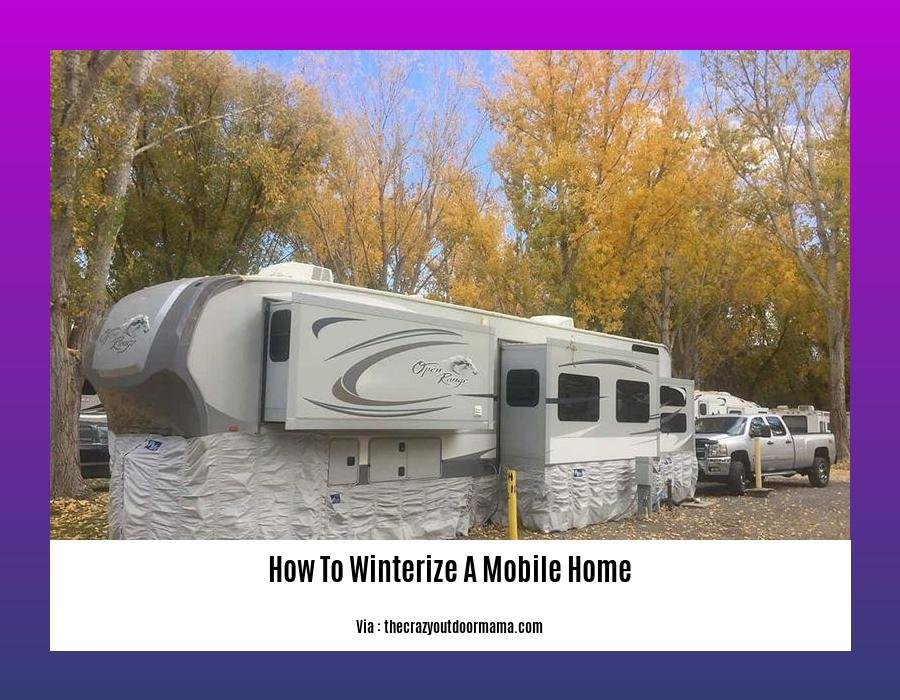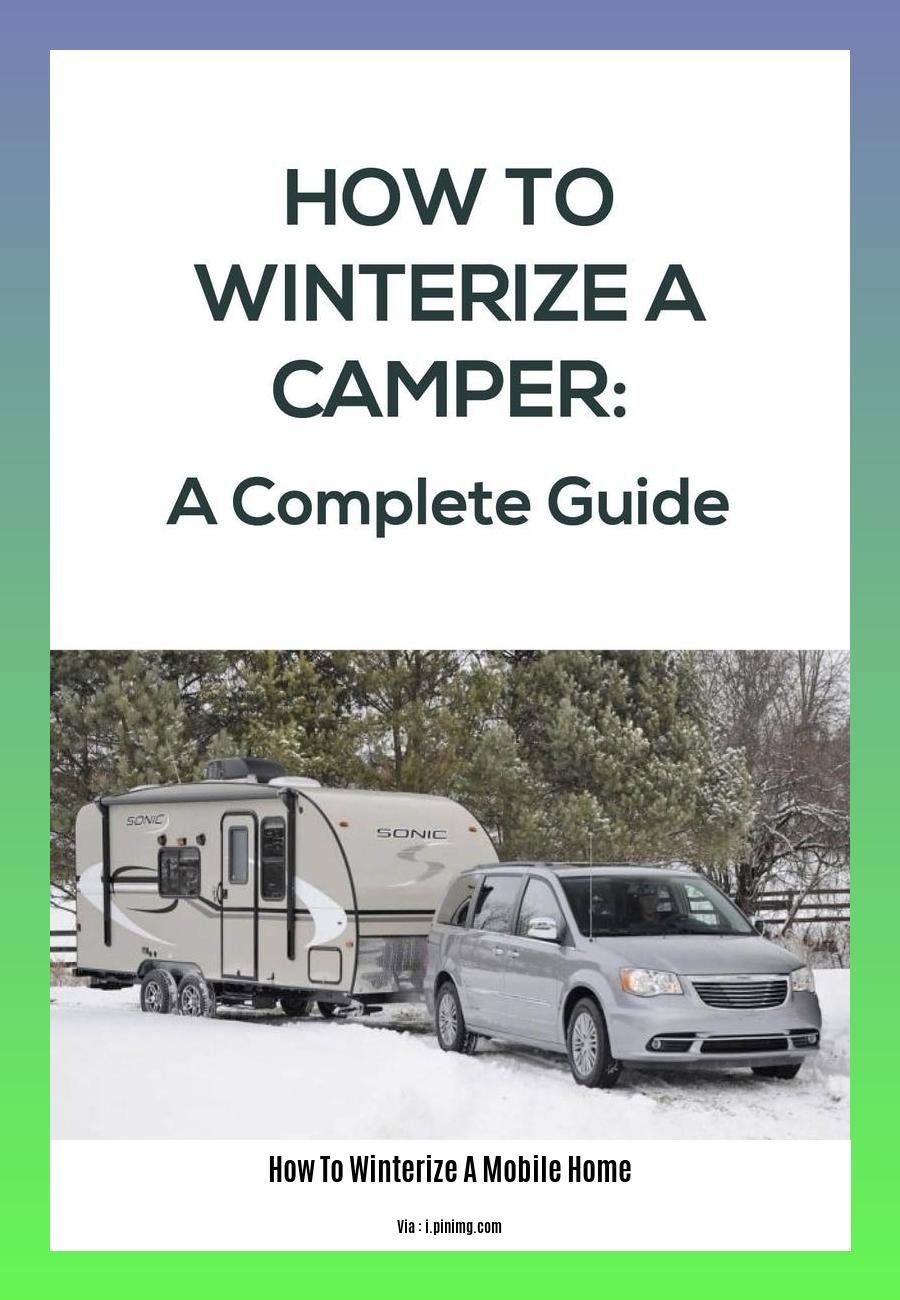Are you a mobile home owner looking to brave the winter? Our comprehensive guide, [How to Winterize a Mobile Home: A Step-by-Step Guide for Homeowners], has got you covered. We’ll take you through crucial steps like winterizing plumbing areas, water heaters, furnace and duct systems, and a bonus tip: cracking open cabinet doors. Prepare your mobile home for the cold and ensure a cozy winter ahead.
Key Takeaways: How to Winterize a Mobile Home
-
Seal gaps: Use caulk to seal cracks and gaps around windows, doors, and other openings to prevent drafts.
-
Winterize windows and doors: Add storm windows, weatherstripping, and caulk around windows and doors to keep cold air out.
-
Check and address insulation: Inspect insulation levels in walls and add more if necessary to improve heat retention.
-
Maintain the furnace: Replace filters and ensure the furnace is operating efficiently to keep the home warm.
-
Adjust tie-downs: Loosen tie-downs to prevent damage from frost heave.
-
Clean gutters: Clear gutters of debris to prevent ice dams and water damage.
-
Protect exposed pipes: Use heat tape or insulation to protect exposed pipes from freezing.
-
Ensure proper ventilation: Maintain adequate ventilation to prevent moisture buildup and mold growth.
-
Address leaks and drafts: Promptly repair any leaks or drafts to prevent further damage.
-
Consider skirting: Install skirting around the mobile home to provide additional insulation and protection from wind and snow.
-
Keep skirting vents open: Ensure skirting vents remain open for air circulation and to prevent moisture accumulation.
How to Winterize a Mobile Home

Winterizing your mobile home is essential for protecting it from the harsh winter elements. By taking proactive steps, you can ensure your mobile home stays cozy and damage-free all season long.
- Seal and Insulate:
- Inspect your mobile home for gaps and cracks around windows, doors, and other openings. Seal these areas with caulk or weatherstripping to prevent drafts and heat loss.
-
Check the insulation in your walls and attic. If it is inadequate, add more to keep warm air in and cold air out.
-
Protect Windows and Doors:
- Install storm windows or add plastic sheeting over your windows to provide an extra layer of insulation.
- Apply weatherstripping around doors and windows to keep cold air from seeping in.
-
Consider installing insulated curtains or blinds to add an extra layer of warmth.
-
Prepare Your Furnace:
- Schedule an inspection and maintenance of your furnace before winter arrives. Ensure it is operating efficiently and replace the filters if necessary.
- Keep the furnace area clear of debris and ensure proper ventilation.
-
Consider installing a programmable thermostat to control the temperature more efficiently.
-
Secure Your Mobile Home:
- Loosen tie-downs to prevent damage from frost heave.
- Inspect the skirting of your mobile home and seal any gaps or tears to prevent cold air from entering.
-
Add skirting insulation to provide additional protection from the wind and snow.
-
Protect Pipes and Plumbing:
- Wrap exposed pipes with heat tape or insulation to prevent them from freezing.
- Insulate crawl spaces and basements to keep pipes warm.
-
Disconnect and drain outdoor hoses and faucets to prevent them from freezing and bursting.
-
Ensure Proper Ventilation:
- Maintain proper ventilation to prevent moisture buildup and potential mold growth.
- Open vents and windows occasionally to allow fresh air to circulate.
-
Use a dehumidifier to control moisture levels in the air.
-
Miscellaneous Tips:
- Keep mobile home skirting vents open to allow for air circulation and prevent moisture buildup.
- Address any leaks or drafts promptly to prevent further damage.
- Consider installing a snow guard system on your roof to prevent snow and ice buildup.
- Store outdoor furniture and decorations safely to prevent damage from winter weather.
By following these steps, you can effectively winterize your mobile home and ensure it is ready to withstand the harsh winter months, keeping it cozy, comfortable, and protected.
Learn the essential steps for preparing your trailer home for the winter months by exploring our comprehensive guide: how to winterize a trailer home.
Discover the distinctions between manufactured and mobile homes, and understand how they compare in terms of construction, regulations, and legal classifications by exploring our detailed comparison: is a manufactured home the same as a mobile home.
Furnace and Duct Systems: A Vital Part of Winterizing Your Mobile Home

When it comes to winterizing your mobile home, don’t forget about your furnace and duct systems. These components play a crucial role in keeping your home warm and comfortable during the chilly months. By taking the time to properly maintain and winterize these systems, you can ensure that your mobile home is ready to withstand the harsh conditions of winter.
Key Takeaways:
-
Properly maintaining your furnace and duct systems is crucial for a warm and comfortable winter in your mobile home.
-
Regular maintenance includes replacing filters, cleaning the system, and inspecting for any signs of damage.
-
Winterizing your furnace and duct systems involves sealing gaps, adding insulation, and checking for leaks.
-
Consider professional maintenance and inspection to ensure optimal performance and prevent potential issues.
-
Addressing any problems with your furnace and duct systems promptly can save you money and hassle in the long run.
Steps to Winterize Your Furnace and Duct Systems:
- Replace Furnace Filters Regularly:
- Replace disposable filters at the beginning of the season and as needed throughout the winter.
-
Clean permanent filters thoroughly with a vacuum or by washing them according to the manufacturer’s instructions.
-
Keep Your Furnace Clean:
- Vacuum the furnace to remove dust and debris, paying attention to the blower motor and coils.
-
Clean the interior of the furnace cabinet to prevent accumulation of dirt and lint.
-
Seal Gaps and Leaks:
- Use caulk or weatherstripping to seal any gaps or leaks around the furnace and ductwork.
-
Inspect the ductwork for holes or tears and repair them using duct tape or mastic sealant.
-
Insulate Your Furnace:
- Consider adding insulation to the furnace cabinet to help retain heat and improve efficiency.
-
Insulate any exposed ductwork to minimize heat loss and prevent drafts.
-
Schedule Regular Maintenance:
- Have your furnace and duct systems inspected and serviced by a qualified technician at least once a year.
-
Regular maintenance can help identify and resolve potential problems before they become major issues.
-
Check for Leaks:
- Inspect the furnace and ductwork for any signs of leaks. Look for moisture, rust, or condensation.
-
If you find any leaks, seal them promptly to prevent heat loss and potential damage.
-
Monitor Your System:
- Keep an eye on your furnace and duct systems throughout the winter.
- If you notice any unusual noises, smells, or decreased efficiency, contact a qualified technician for further inspection.
By following these steps, you can ensure that your furnace and duct systems are ready to keep your mobile home warm and comfortable all winter long. Remember, a well-maintained and winterized heating system not only provides comfort but also saves you money on energy bills.
Citations:
Mobile Home Living
Upgraded Home
Tip 1: Crack Open Cabinet Doors
During the winter months, it’s crucial to ensure proper heat distribution throughout your mobile home to prevent cold spots and freezing pipes. One simple yet effective method to achieve this is by opening cabinet doors.
Cracking open cabinet doors allows warm air from your heating system to circulate more effectively throughout the home. This seemingly minor step can go a long way in preventing frozen pipes and maintaining a comfortable indoor temperature. By facilitating heat flow into enclosed spaces, you can prevent cold air from settling in and causing discomfort or potential damage to your plumbing.
Key Takeaways:
- Opening cabinet doors helps circulate warm air throughout the home.
- Improved heat distribution prevents cold spots and lowers the risk of freezing pipes.
- This simple step contributes to maintaining a comfortable indoor temperature.
- It’s an easy and effective way to prevent potential plumbing issues.
Relevant URL Sources:
- How to Winterize Your Manufactured Home: A Step-by-Step Guide
- 7 Tips for Winterizing Your Manufactured Home]
FAQ
Q1: Can closing cabinet doors help prevent freezing pipes?
A1: No, on the contrary, it’s recommended to crack open cabinet doors to allow heat circulation and prevent cold spots that could lead to freezing pipes.
Q2: Is it necessary to let faucets drip during winter to prevent freezing?
A2: Yes, dripping faucets can help prevent freezing by keeping water moving. This is especially important if you’ll be away from home for an extended period.
Q3: How can ceiling fans assist in distributing heat evenly throughout a mobile home during winter?
A3: By reversing the direction of ceiling fans during winter, you can redistribute warm air that rises towards the ceiling, ensuring a more balanced and efficient heat distribution.
Q4: Why is it crucial to keep gutters clear during winter?
A4: Clogged gutters can lead to ice dams, which are barriers of ice that form along the edges of a roof and can cause water backup, leaks, and damage to the roof. Regular gutter cleaning is essential for preventing ice dams.
Q5: How can I minimize heat loss through windows and doors during winter?
A5: Applying weatherstripping around windows and doors can significantly reduce heat loss. Additionally, installing storm windows or double-glazed windows can provide extra insulation and energy efficiency.
- Backsplash For Cooktop: Stylish Ideas To Protect and Enhance - December 25, 2025
- Stove Backsplash Ideas: Find Your Perfect Kitchen Style - December 24, 2025
- Stovetop Backsplash Ideas: Stylish Protection for Your Kitchen Cooking Zone - December 23, 2025










